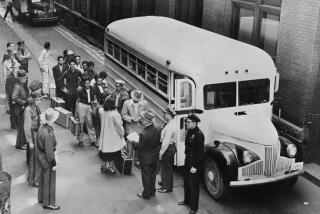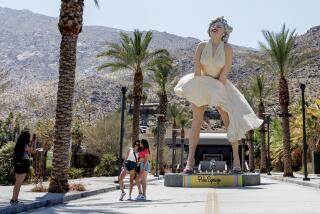Black, White Feminists Are Caught Up in Monumental Scrap : At issue is statue of suffragettes to be displayed in Capitol. African Americans want Sojourner Truth included with Lucretia Mott, Elizabeth Cady Stanton, Susan B. Anthony.
- Share via
WASHINGTON — A controversy over the placement of a statue in the Capitol Rotunda has escalated into a monumental battle, pitting white and black feminists in a competition to recognize women’s struggle for the right to vote.
The contretemps stems from a hard-won victory by a predominantly white coalition of women’s rights activists to have a statue of three suffrage leaders--Lucretia Mott, Susan B. Anthony and Elizabeth Cady Stanton--lifted from obscurity in the Capitol basement to a premier spot on the west side of the Rotunda.
After a long, hard-fought campaign to secure congressional authorization for the move, the activists prevailed. Now, a coalition of black women’s groups is demanding that the suffrage memorial include Sojourner Truth, a 19th-century abolitionist and women’s rights contemporary of the white women.
“We all agree that a suffrage statue is proper and should be placed in the Rotunda,” said C. Delores Tucker, chairwoman of the National Political Congress of Black Women Inc., and the leader of a group protesting the raising of the statue. “But we can’t let this statue be placed in the Rotunda without Sojourner Truth.”
Karen Staser, founder and president of the National Museum of Women’s History, a nascent Alexandria, Va., feminist group, said her organization is championing the move of the suffrage statue as “a foot in the door to begin restoring the history of women’s contributions.”
Staser said she does not intend to exclude Truth and that she believes the onetime-slave-turned-orator deserves a place under the Capitol dome. But since there is already a historic suffrage statue, Staser said, it would be wrong to keep it in the basement because it lacks Truth’s likeness.
“We do agree that Sojourner Truth was a very important historical figure, and we’re working with Dr. Tucker and Congress to find a place for Sojourner Truth,” she said.
Commissioned by the National Women’s Party to commemorate the 1920 passage of the 19th Amendment giving women the right to vote, the statue was carved in Italy by Adelaide Johnson and given to Congress in 1921. Congressional leaders rejected the statue at first, but under protests from women’s groups, relented and brought the monument into the Rotunda. After a gala celebration that drew an estimated 5,000 people, lawmakers banished the statue to a broom closet in the Capitol basement.
In 1963, the statue was moved to the Capitol crypt, a passageway in the basement, where it now stands. After several failed attempts to move the statue to the Rotunda, where none of the 11 busts and statues is of a woman, lawmakers voted last year to allow it to return to the main Statuary Hall. To make room for the women, a statue of Rhode Island founder Roger Williams will be moved out of the Rotunda.
“We thought we had it made and that our long struggle was finally over until we heard from Dr. Tucker about her concerns with Sojourner Truth,” Staser said. “We understand her concerns, and I’m sure we’ll work them out somehow.”
Both Staser and Tucker said previous meetings have left them frustrated and no additional meetings have been scheduled. In other words, both sides are locked into their respective positions.
Meanwhile, other influential onlookers--including some female members of Congress--said they are feeling uncomfortable as they are being swept into the controversy and pressured to choose between gender and race.
“This is clearly a squabble that a lot of people wish would go away,” said Adele Alexander, a George Washington University history professor and an expert on black women’s issues and the suffrage movement.
Alexander, who is black and is working as a consultant to the National Women’s Museum, said she favors moving the statue and lobbying Congress to place an additional memorial in the Rotunda to commemorate Truth’s life and work.
“I would very much like to see some acknowledgment of the role African American women have played in the women’s rights movement represented in the Capitol, but holding up this statue isn’t the way to do it,” she said, adding that it would be wrong both in terms of art and history to attempt to carve Sojourner Truth into the existing statue.
“You don’t try to put arms on the Venus de Milo,” Alexander said. “If you were to carve Sojourner Truth into the back of that statue, it would essentially be saying that those suffragettes prior to 1920 were not excluding black women from their efforts, which they were.”
But that’s exactly the reason she should be on the same podium as the white suffrage movement leaders, Tucker said.
Tucker pointed to historical documents that make clear black women were shunned from the 19th-century suffrage movement by white women. Although the 19th Amendment did not exclude black women they--and black men--remained disenfranchised in parts of the country by Jim Crow-era laws.
Sojourner Truth was born into slavery as Isabella Baumfree in 1797 in Ulster County, N.Y. She gained her freedom in 1828 under a New York state law banning slavery and, in 1843, underwent a religious experience that persuaded her to change her name as she embarked on a crusade to preach against slavery and oppression of women.
A powerful, dramatic speaker, Truth was one of the few black women to draw an audience among white suffrage movement leaders, often challenging the racism within their own groups.
Turner said it would demean Truth’s spirit for African American women to allow a statue honoring the suffrage movement to silence the strongest black voice of that day. Vowing “to wage all-out combat, if necessary,” Turner said she and her group have placed stopping the relocation of the statue without Sojourner Truth at the top of its agenda.
“What we’re saying, clearly and forcefully, is that we cannot let black women step back again and allow white women to go first,” Tucker said. “We can’t--and won’t--let that happen again.”
At this point, however, proponents say the move is a done deal. Arguing that they have secured congressional approval, raised $75,000 and signed contracts to relocate the 7-ton, Carerra and Italian marble figures to the Rotunda sometime around May 8.
“Indeed, it is going to happen,” said Kathryn Dieteman, a spokeswoman for Sen. John W. Warner (R-Va.), who has been a chief supporter of the move. “We are aware of concerns [about Sojourner Truth] but the move is about to happen. Only the date is uncertain.”
But nothing is ever final in Washington, opponents say.
Tucker is circulating a pink-paper petition among black women’s groups in an effort to pressure lawmakers to stop the move. Her efforts have attracted some support from black historians and political activists, including a supportive letter from the District of Columbia branch of the NAACP that urged the inclusion of Truth on the statue. “Anything else would be unthinkable,” it stated.
Additionally, Rep. Cynthia A. McKinney (D-Ga.), is preparing to introduce a measure to block the move unless the memorial includes Truth. The proposed concurrent resolution would call on Congress “to revise the statue commemorating women’s suffrage located in the United States Capitol to include a likeness of Sojourner Truth.”
More to Read
Get the L.A. Times Politics newsletter
Deeply reported insights into legislation, politics and policy from Sacramento, Washington and beyond. In your inbox twice per week.
You may occasionally receive promotional content from the Los Angeles Times.










